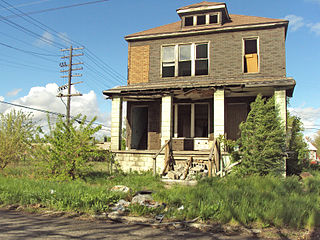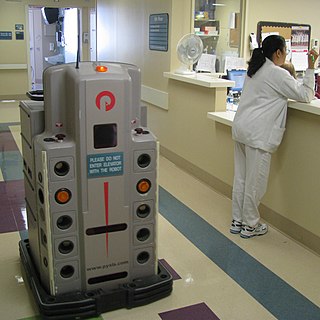A trade union or labor union, often simply referred to as a union, is an organisation of workers whose purpose is to maintain or improve the conditions of their employment, such as attaining better wages and benefits, improving working conditions, improving safety standards, establishing complaint procedures, developing rules governing status of employees and protecting and increasing the bargaining power of workers.

Economic growth can be defined as the increase or improvement in the inflation-adjusted market value of the goods and services produced by an economy in a financial year. Statisticians conventionally measure such growth as the percent rate of increase in the real and nominal gross domestic product (GDP).

Import substitution industrialization (ISI) is a trade and economic policy that advocates replacing foreign imports with domestic production. It is based on the premise that a country should attempt to reduce its foreign dependency through the local production of industrialized products. The term primarily refers to 20th-century development economics policies, but it has been advocated since the 18th century by economists such as Friedrich List and Alexander Hamilton.

Industrialisation (UK) or industrialization (US) is the period of social and economic change that transforms a human group from an agrarian society into an industrial society. This involves an extensive reorganisation of an economy for the purpose of manufacturing. Industrialisation is associated with increase of polluting industries heavily dependent on fossil fuels. With the increasing focus on sustainable development and green industrial policy practices, industrialisation increasingly includes technological leapfrogging, with direct investment in more advanced, cleaner technologies.
In economics, Dutch disease is the apparent causal relationship between the increase in the economic development of a specific sector and a decline in other sectors.

The Rust Belt is a region of the Northeastern and Midwestern United States. It includes Central New York, Pennsylvania, Ohio, West Virginia, Indiana, Illinois, the Lower Peninsula of Michigan, southeastern Wisconsin, parts of Kentucky, Baltimore, and the St. Louis metropolitan area in Missouri. Cities in the Rust Belt include Allentown, Buffalo, Cincinnati, Cleveland, Detroit, Gary, Philadelphia, Pittsburgh, Rochester, Toledo, Trenton, and Youngstown.
Labor intensity is the relative proportion of labor used in any given process. Its inverse is capital intensity.
In economics, the Baumol effect, also known as Baumol's cost disease, is the rise of wages in jobs that have experienced little or no increase in labor productivity in response to rising wages in other jobs that have experienced higher productivity growth. The phenomenon was described by William J. Baumol and William G. Bowen in the 1960s and is an example of cross elasticity of demand.

The Great Divergence or European miracle is the socioeconomic shift in which the Western world overcame pre-modern growth constraints and emerged during the 19th century as the most powerful and wealthy world civilizations, eclipsing previously dominant or comparable civilizations from the Middle East and Asia such as the Ottoman Empire, Mughal India, Safavid Iran, Qing China, and Tokugawa Japan, among others.

Shrinking cities or urban depopulation are dense cities that have experienced a notable population loss. Emigration is a common reason for city shrinkage. Since the infrastructure of such cities was built to support a larger population, its maintenance can become a serious concern. A related phenomenon is counterurbanization.
Economic restructuring is used to indicate changes in the constituent parts of an economy in a very general sense. In the western world, it is usually used to refer to the phenomenon of urban areas shifting from a manufacturing to a service sector economic base. It has profound implications for productive capacities and competitiveness of cities and regions. This transformation has affected demographics including income distribution, employment, and social hierarchy; institutional arrangements including the growth of the corporate complex, specialized producer services, capital mobility, informal economy, nonstandard work, and public outlays; as well as geographic spacing including the rise of world cities, spatial mismatch, and metropolitan growth differentials.

The economic history of the Netherlands (1500–1815) is the history of an economy that scholar Jan de Vries calls the first "modern" economy. It covers the Netherlands as the Habsburg Netherlands, through the era of the Dutch Republic, the Batavian Republic and the Kingdom of Holland.
The steel crisis was a recession in the global steel market during the 1973–75 recession and early 1980s recession following the post–World War II economic expansion and the 1973 oil crisis, further compounded by the 1979 oil crisis, and lasted well into the 1980s.

The post–World War II economic expansion, also known as the postwar economic boom or the Golden Age of Capitalism, was a broad period of worldwide economic expansion beginning with the aftermath of World War II and ending with the 1973–1975 recession. The United States, the Soviet Union and Western European and East Asian countries in particular experienced unusually high and sustained growth, together with full employment.

Robert Rowthorn FAcSS FLSW is Emeritus Professor of Economics at the University of Cambridge and has been elected as a Life Fellow of King’s College. He is also a senior research fellow of the Centre for Population Research at the Department of Social Policy and Intervention, University of Oxford.

Manufacturing is a vital economic sector in the United States. The United States is the world's third largest manufacturer with a record high real output in 2021 of $2.5 trillion. The U.S. manufacturing industry employed 12.35 million people in December 2016 and 12.56 million in December 2017, an increase of 207,000 or 1.7%. Though still a large part of the US economy, in Q1 2018 manufacturing contributed less to GDP than the 'Finance, insurance, real estate, rental, and leasing' sector, the 'Government' sector, or 'Professional and business services' sector.

Technological unemployment is the loss of jobs caused by technological change. It is a key type of structural unemployment. Technological change typically includes the introduction of labour-saving "mechanical-muscle" machines or more efficient "mechanical-mind" processes (automation), and humans' role in these processes are minimized. Just as horses were gradually made obsolete as transport by the automobile and as labourer by the tractor, humans' jobs have also been affected throughout modern history. Historical examples include artisan weavers reduced to poverty after the introduction of mechanized looms. During World War II, Alan Turing's bombe machine compressed and decoded thousands of man-years worth of encrypted data in a matter of hours. A contemporary example of technological unemployment is the displacement of retail cashiers by self-service tills and cashierless stores.
International trade theory is a sub-field of economics which analyzes the patterns of international trade, its origins, and its welfare implications. International trade policy has been highly controversial since the 18th century. International trade theory and economics itself have developed as means to evaluate the effects of trade policies.
Deindustrialisation refers to the process of social and economic change caused by the removal or reduction of industrial activity and employment in a country or region, especially heavy industry or manufacturing industry. Deindustrialisation is common to all mature Western economies, as international trade, social changes, and urbanisation have changed the financial demographics after World War II. Phenomena such as the mechanisation of labour render industrial societies obsolete, and lead to the de-establishment of industrial communities.
The economic de-industrialisation of India refers a period of reduction in industrial based activities within the Indian economy from 1757 to 1947. The process of de-industrialisation is an economic change in which employment in the manufacturing sector declines due to various economic or political reasons. The decline in employment in manufacturing is also followed by the fall in the share of manufacturing value added in GDP. The process of de-industrialisation can be due to development and growth in the economy and it can also occur due to political factors.












